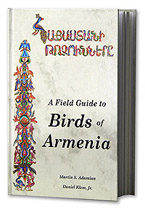- Pictures of All Birds
- Find Bird by Common Name
- Find Bird by Scientific Name
- Find Bird by Armenian Name
- Orders of Birds
- Distribution Maps
- Location of Armenia
- Species of Special Concern

Purchase the Field Guide
© Copyright Birds
of Armenia Project

| Armenian Name: | Վայրի հնդկահավ (ուլար) |
|---|---|
| Species Status: | Threatened Species - Species of Special Concern |

See Plate 20 for Caspian Snowcock and other similar species
| Resident Status: | Year-round resident |
|---|---|
| Abundance: | Uncommon |
| Length: | 58-62 cm, Wing Span:95-105 cm |
| Distribution Map: | Map 90. |
| Description: | Huge snow partridge found only in alpine and subalpine zones. Appears gray overall with fine red-brown, yellow-brown, and black markings on wing coverts and underparts. Chin and throat white, with gray cheek stripe and necklace. Upper breast bluish-gray sparsely spotted with brown. White wing stripe very conspicuous in flight. Females and juveniles smaller, more yellowish-brown on head and neck. |
| Behavior: | Glides rapidly down slopes on stiff wings before landing on broken rocky ground where very difficult to see; walks slowly back uphill, feeding along the way. Sunbathes on huge boulders. Usually indicates presence with a loud piercing whistle, audible for up to one kilometer. |
| Habitat: | Steep alpine meadows with numerous rock outcroppings and stony slopes. Occurs at 2400-3900m, remaining at high elevations even during winter. |
| Food: | Plants including seeds, roots, and bulbs. |
| Nest: | Cup of dry grass lined with feathers, usually placed under overhanging rock, in crevice, or within tussock of grass. |
| Eggs: | 66 mm, 6-9, gray-green, darker blotches. |